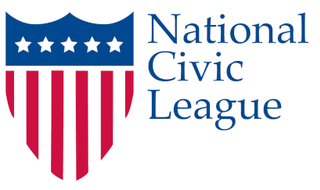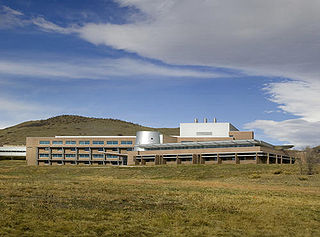
The National Civic League is an American nonpartisan, non-profit organization founded in 1894 as the "National Municipal League," it adopted its new name in 1937. Its mission is to advance civic engagement to create equitable, thriving communities. To upgrade quality and efficiency of government in cities it enlists the business and professional classes, and promotes greater involvement in government. It also sought create merit-based systems for selecting public officials. The League envisions a country where the full diversity of community members are actively and meaningfully engaged in local governance, including both decision making and implementation of activities to advance the common good. It also promotes professional management of local government through publication of "model charters" for both city and county governments.

The National Renewable Energy Laboratory (NREL) in the US specializes in the research and development of renewable energy, energy efficiency, energy systems integration, and sustainable transportation. NREL is a federally funded research and development center sponsored by the Department of Energy and operated by the Alliance for Sustainable Energy, a joint venture between MRIGlobal and Battelle. Located in Golden, Colorado, NREL is home to the National Center for Photovoltaics, the National Bioenergy Center, and the National Wind Technology Center.

A Zero-Energy Building (ZEB), also known as a Net Zero-Energy (NZE) building, is a building with net zero energy consumption, meaning the total amount of energy used by the building on an annual basis is equal to the amount of renewable energy created on the site or in other definitions by renewable energy sources offsite, using technology such as heat pumps, high efficiency windows and insulation, and solar panels.
The Office of Energy Efficiency and Renewable Energy (EERE) is an office within the United States Department of Energy. Formed from other energy agencies after the 1973 energy crisis, EERE is led by the Assistant Secretary of Energy Efficiency and Renewable Energy, who is appointed by the president of the United States and confirmed by the U.S. Senate. Alejandro Moreno currently leads the office as the Acting Assistant Secretary.

Solar Cities is an innovative A$97 million demonstration programme designed to promote solar power, smart meters, energy conservation and new approaches to electricity pricing to provide a sustainable energy future in urban locations throughout Australia. Adelaide, Alice Springs, Blacktown, Central Victoria and Townsville were nominated to be the first Solar Cities of Australia, in the 2007 election campaign the Labor government committed to expanding the programme to include Coburg and Perth. Solar Cities is an innovative program that aims to show how technology, behavior change, and new approaches to energy pricing can combine to provide a sustainable energy future in urban locations throughout Australia".

According to data from the US Energy Information Administration, renewable energy accounted for about 13.1% of total primary energy consumption and about 21.5% of total utility-scale electricity generation in the United States in 2022.

Community Choice Aggregation (CCA), also known as Community Choice Energy, municipal aggregation, governmental aggregation, electricity aggregation, and community aggregation, is an alternative to the investor-owned utility energy supply system in which local entities in the United States aggregate the buying power of individual customers within a defined jurisdiction in order to secure alternative energy supply contracts. The CCA chooses the power generation source on behalf of the consumers.
A feed-in tariff is a policy mechanism designed to accelerate investment in renewable energy technologies by offering long-term contracts to renewable energy producers. This means promising renewable energy producers an above-market price and providing price certainty and long-term contracts that help finance renewable energy investments. Typically, FITs award different prices to different sources of renewable energy in order to encourage the development of one technology over another. For example, technologies such as wind power and solar PV are awarded a higher price per kWh than tidal power. FITs often include a "digression": a gradual decrease of the price or tariff in order to follow and encourage technological cost reductions.

Solar power includes solar farms as well as local distributed generation, mostly on rooftops and increasingly from community solar arrays. In 2022, utility-scale solar power generated 145.6 terawatt-hours (TWh), or 3.4% of electricity in the United States. Total solar generation that year, including estimated small-scale photovoltaic generation, was 204 TWh.
The Climate Investment Funds (CIF) was established in 2008 as a multilateral climate fund in order to finance pilot projects in developing countries at the request of the G8 and G20. The CIF administers a collection of programs with a view to helping nations fight the impacts of climate change and accelerate their shift to a low-carbon economy. Through contributions from 14 donor countries, CIF supports more than 350 projects in 72 low and middle-income countries on the frontlines of the climate crisis.

Community wind projects are locally owned by farmers, investors, businesses, schools, utilities, or other public or private entities who utilize wind energy to support and reduce energy costs to the local community. The key feature is that local community members have a significant, direct financial stake in the project beyond land lease payments and tax revenue. Projects may be used for on-site power or to generate wholesale power for sale, usually on a commercial-scale greater than 100 kW.

As of 2019, renewable energy technologies provide about 17.3% of Canada's total primary energy supply. For electricity renewables provide 67%, with 15% from nuclear and 18% from hydrocarbons.

A community solar project, farm or garden is a solar power installation that accepts capital from and provides output credit and tax benefits to multiple customers, including individuals, businesses, nonprofits, and other investors. Participants typically invest in or subscribe to a certain kW capacity or kWh generation of remote electrical production. The project's power output is credited to investors or subscribers in proportion to their investment, with adjustments to reflect ongoing changes in capacity, technology, costs and electricity rates. Community solar provides direct access to the renewable energy to customers who cannot install it themselves. Companies, cooperatives, governments or non-profits operate the systems.

The Interstate Renewable Energy Council (IREC), established in 1982, is a non-profit organization working with clean energy. It is based in Latham, New York.

Climate change has had a number of impacts on the US state of Montana. Heat waves are becoming more common, snow is melting earlier in the spring, and trees are dying as a result of drought, forest fire, and increased prevalence of forest insects. In the next few decades in Montana, climate change is most likely to impact water availability, agricultural yields, and wildfire risk. State and local governments have taken legislative steps, such as establishing a renewable energy portfolio and creating climate action plans, to mitigate the effects of climate change.

Gregory H. Kats is an American businessman, environmentalist, and thought leader in the green economy sector. He is founder and CEO of the Smart Surfaces Coalition, a non-profit organization consisting of 40+ national and international partner groups working to ensure the rapid, cost-effective adoption of reflective, porous, and green urban surface infrastructure, or "smart surfaces", in cities. Previously, Kats served as a Managing Director at Good Energies,[2] a multi-billion dollar global clean energy investor, and Director of Financing for Energy Efficiency and Renewable Energy at the U.S. Department of Energy (DOE).[3]

Most of Kenya's electricity is generated by renewable energy sources. Access to reliable, affordable, and sustainable energy is one of the 17 main goals of the United Nations’ Sustainable Development Goals. Development of the energy sector is also critical to help Kenya achieve the goals in Kenya Vision 2030 to become a newly industrializing, middle-income country. With an installed power capacity of 2,819 MW, Kenya currently generates 826 MW hydroelectric power, 828 geothermal power, 749 MW thermal power, 331 MW wind power, and the rest from solar and biomass sources. Kenya is the largest geothermal energy producer in Africa and also has the largest wind farm on the continent. In March 2011, Kenya opened Africa's first carbon exchange to promote investments in renewable energy projects. Kenya has also been selected as a pilot country under the Scaling-Up Renewable Energy Programmes in Low Income Countries Programme to increase deployment of renewable energy solutions in low-income countries. Despite significant strides in renewable energy development, about a quarter of the Kenyan population still lacks access to electricity, necessitating policy changes to diversify the energy generation mix and promote public-private partnerships for financing renewable energy projects.
A renewable portfolio standard (RPS) is a regulation that requires the increased production of energy from renewable energy sources, such as wind, solar, biomass, and geothermal. Other common names for the same concept include Renewable Electricity Standard (RES) at the United States federal level and Renewables Obligation in the UK.
The SunShot Initiative is a federal government program run by the US Department of Energy's Solar Energy Technologies Office. It bills itself as a national effort to support solar energy adoption in order to make solar energy affordable for all Americans. The initiative is a collaboration of private companies, universities, state and local governments, and nonprofits, as well as national laboratories.
EnergySage is an American Boston-based company that operates an online comparison marketplace for clean energy products such as solar, energy storage, and heat pumps. The company's website provides information about clean energy options and shows online quotes from local solar, heat pump, and battery installers for consumer comparison shopping. The company also issues reports and survey results on the state of the clean energy industry regarding pricing, consumer preferences, and trends.













